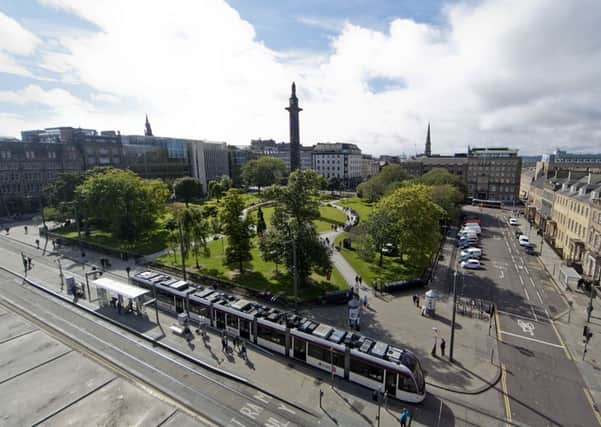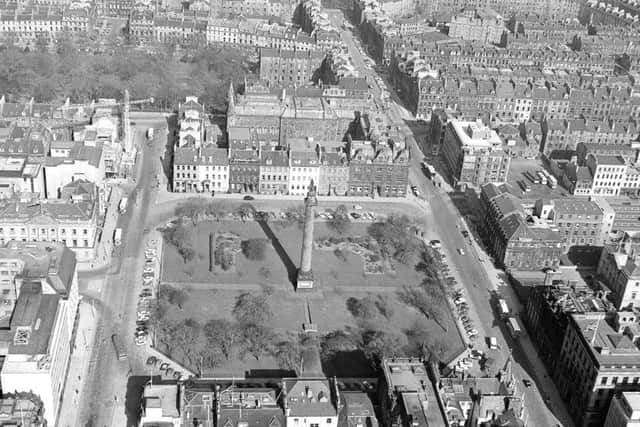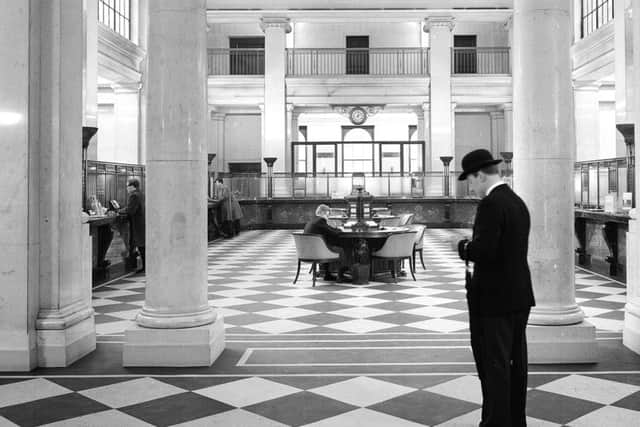The transformation of St Andrew Square


In the 1780s St Andrew Square was probably the most fashionable address in Edinburgh’s New Town.
The philosopher David Hume lived at No 8, while other notable inhabitants included the Earl of Northesk, the Countess Dowager of Leven, the banker Sir William Forbes and Sir Lawrence Dundas whose impressive home, Dundas House, became the headquarters of the Royal Bank of Scotland.
Advertisement
Hide AdAdvertisement
Hide AdThe “who’s who” of Edinburgh would have been able to count various financial institutions among their neighbours; the British Linen Bank at 38-39 St Andrew Square, before it was taken over by the Bank of Scotland, and Scottish Widows at No 5.


Banks, in their heyday, didn’t advertise their services, but instead displayed their wealth and stability through lavish displays of grand architecture and opulent décor, such as the stunning starred dome which is still visible today in the RBS branch at No 36, Dundas House.
The rows of tellers’ desks are a thing of the past – although it must be said that RBS’s refurbishment of the house in 2015 was particularly sympathetic to the building’s history – and the former banking halls and offices that lined the edges of St Andrew Square, on the whole, look quite different.
As the financial heavyweights outgrew their offices and moved to larger out-of-town complexes like Gogarburn and the Gyle, floors in the prime city centre location lay vacant. But in recent years, the Georgian site has undergone something of a transformation.
The change actually started in the 19th century when a lot of internal changes were made to buildings in St Andrew Square.


The first major transformation was that of No 1, which was altered for office use in 1892 and was home to the life insurance and financial services company Prudential.
Functional commercial builds replaced original architecture during the 1960s and 1970s; the Scottish Provident Headquarters was developed on the south side of the square in a series of phased developments between 1954 and 1994.
When the Abbey Group, which acquired Scottish Provident in the late 1990s, closed the building, it became ripe for redevelopment once more. Today it’s the site of the distinctive gold and glass Standard Life development, the street level of which has been dubbed Edinburgh’s “cuisine quarter”.
Advertisement
Hide AdAdvertisement
Hide AdThe arrival of the luxury brands we have come to associate with St Andrew Square started in 2003 with the construction of Multrees Walk, built to connect the square to the original 1970s St James Centre, which is of course now undergoing a transformation of its own into the skyline-altering Edinburgh St James complex.


From Harvey Nichols with its far-reaching views from the top-floor restaurant to Valvona & Crolla’s Vincaffè, the glossy Nespresso shop, Tesla concept store and designer names – Burberry, Mulberry, Louis Vuitton, Swarovski – it’s definitely more shoppers’ paradise than bank managers’ meetings.
“There has been a lot of change over time,” says Cliff Hague, chairman of the Cockburn Association.
“Multrees Walk really starts the modern phase off and the trajectory of more recent change was, I think, set from that time on.”
Work stopped with the financial crash of 2007.


“To a certain extent, what we are seeing now is the working through of ideas that were out there ten years ago,” says Hague. “The permission for the major Standard Life development was given in 2007 but the work didn’t get started really until 2014.
“What is clearly happening is a repositioning around retail and mixed-use but still with some office functions.”
The same could be said of George Street, where classy cocktail bars and top-end high street favourites have crept in, making it a popular spot for eating, drinking and splashing some cash.
Since 2014, most of the activity in St Andrew Square itself has centred around the south side.
Advertisement
Hide AdAdvertisement
Hide Ad“We could see the area changing with the development of St James and we realised that it was a prime site that hadn’t been developed for quite some time,” says David Stewart, fund manager, Standard Life Pooled Property Pension Fund.
“With the tram and the proximity to Waverley, as well as the overall supply and demand dynamics in terms of Grade A office space in the city, we really wanted to create a mixed-use development that fulfilled the potential of the site.”
Above the restaurant units there’s vast open-plan office space which has been let to Aberdeen Standard Investments with modern workplace requirements in mind.
More recently, vacant office space at No 1 has been extended and refurbished – or rather “de-furbished” – after Standard Life Investments Pooled Pension Property Fund bought the building from Tonstate Group for £15 million in 2015.
“We have put in Wahaca [the Mexican restaurant chain] round the corner and have just recently refurbished all the office space in quite an unusual format with exposed surfaces,” explains Stewart.
“We have kept quite a lot of features within the building. I think it will have broad appeal but particularly to media and technology companies.”
The arrival of media and tech businesses would add yet another dimension to this rapidly changing part of the capital.
At street level it’s a foodies’ paradise. There’s Bombay café Dishoom which serves some exotic combinations including a bacon naan roll. Inside, the design pays homage to the Irani cafés that were once part of the fabric of life in Bombay.
Advertisement
Hide AdAdvertisement
Hide AdThen there’s Wagamama serving Asian-inspired and Japanese food to diners seated along friendly, communal tables.
The Refinery is decked out with cool but cosy interiors complete with hot water bottles and throws to keep customers warm at outdoor tables. It’s Drake & Morgan’s first Scottish venture and since it opened in November last year it has been notoriously difficult to get a table – clearly it’s a hit on the Edinburgh restaurant scene.
Vapiano focuses on the family market dishing up Italian pasta favourites, while the Argentine steakhouse Gaucho was announced as completing the line-up earlier this month. With nine restautrants in London, Gaucho’s first venture north of the Border is eagerly anticipated.
The jewel in the crown is probably the Ivy, another highlight of the London food scene – although it’s perhaps too early to say since it only opened on 20 September.
“We have quite a range of tenants and they all have a different offer,” says Stewart. “We have been working with them all so they can put in high-quality shop fits. “The Ivy is creating quite a lot of buzz at the moment.”
It might look sparkly and new at first glance – and the jury’s still out on whether the contemporary additions to the square are entirely in keeping with New Town style – but Stewart says care was taken to ensure the modern builds don’t look too out of place.
“The proportions have been designed to have regard to the existing buildings in the square,” he says, acknowledging: “It’s obviously quite different though.
“There was existing planning consent when we acquired the property which we have modified slightly in terms of the front elevation but we think it does have regard to the scale and proportion of the other buildings within the square.
Advertisement
Hide AdAdvertisement
Hide Ad“We thought it was a really great piece of real estate in terms of its fundamentals and location and we thought it was a real opportunity to do something quite special.
“We are very pleased with the outcome.”
The garden at the centre of St Andrew Square has become a relaxation space for workers from nearby shops and offices, as well as playing host to seasonal events.
It first opened to the public in 2008 and became a Fringe venue in 2014, although that ended this year after the owners of properties around the square called for a clampdown on its use for major events.
“The argument for having the Fringe in the square was that it would be some recompense for the trams, bringing more footfall and spending into that part of the New Town, and it would complement the Book Festival,” says Hague.
“If you look over a 20-year period or so, you do see quite a considerable shift from the traditional Edinburgh banking and insurance towards more retail and leisure entertainment.”
Buchan House on the Queen Street side of St Andrew Square was once the Edinburgh office of global tech giant IBM and in July plans were announced for its transformation into a 72-room hotel with restaurant and bar areas.
The main part of the Grade A-listed building dates back to 1775 when it was built as five houses by the renowned architect and builder John Young.
Much like the buildings on the south side, Buchan House has stood empty for a number of years, so perhaps it’s about time it’s given a new lease of life.
Advertisement
Hide AdAdvertisement
Hide AdA look at the transformation of St Andrew Square wouldn’t be complete without mentioning the work that’s going on at No 42.
Started in the late 1930s and completed in 1942, the building served as the headquarters of the National Commercial Bank of Scotland before becoming the global head office for the Royal Bank of Scotland, which vacated the space in 2007.
Inside, it’s nothing short of spectacular. No 42 was designed by architects Leslie Grahame Thomson and Arthur Davis, who is probably best known for being the interior architect of the Ritz Hotel in London, as well as ocean liners the Aquitania and the Queen Mary.
The H-shaped building is an example of early modern neoclassical architecture, inspired by the bank buildings of 1930s America, however significant modifications in the 1970s spoiled much of the grandeur of the space.
It’s now the ambitious project of the Chris Stewart Group which is restoring many of the original features as it transforms the building into luxury serviced apartments and a food and drink destination, under the name the Edinburgh Grand.
The Chris Stewart Group is also working on what will be known as the Mint Building. Together with No 42, the pair form the Registers development. When complete, the Mint Building will comprise 61,000sq ft of Grade A office accommodation over eight floors, plus retail and restaurant space on the ground floor.
“The project will create state-of-the-art offices and retail/restaurant space to sit alongside renovated traditional Edinburgh architecture and bring to an end a lengthy period where the site has been vacant and in a state of disrepair,” says Chris Stewart, chief executive of the Chris Stewart Group.
“Once the project is complete Edinburgh can look forward to a regenerated and strategically important city centre destination.”
This article appears in the AUTUMN 2017 edition of Vision Scotland. An online version is available here.